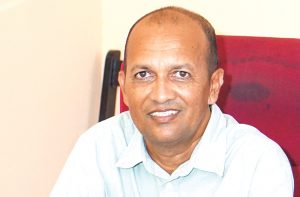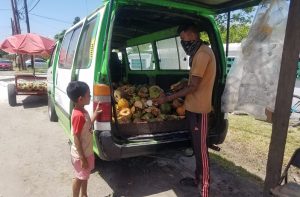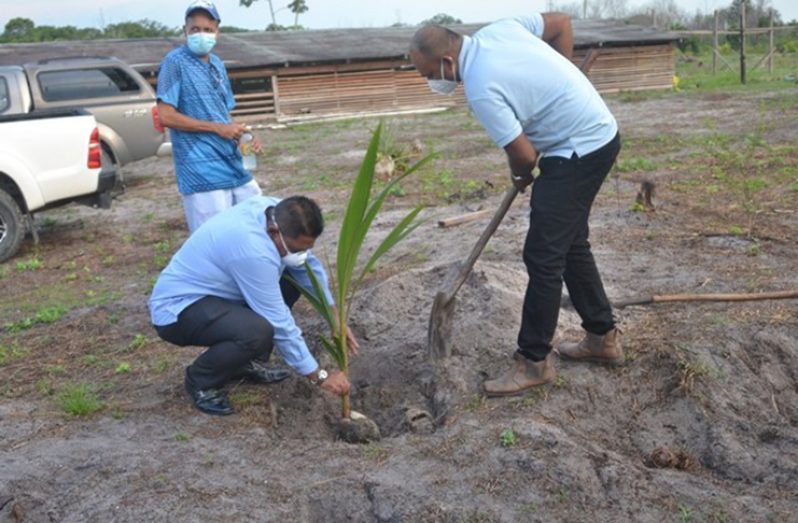— to meet local demand and export markets
OUTSIDE of rice and sugar, not many know that coconut is the third major agricultural export, earning some US$7M in export revenues in 2017 and there are concerted efforts afoot to transform the industry in the years to come.

With demand globally forecasted to experience huge growth, with right positioning, Guyana could get a fair share of the global market. Currently, there are massive investments, both at the private and public levels, geared at putting Guyana on the right path.
“The present demand for coconuts and its by-products are on the increase and this augurs well both for farmers and other stakeholders involved in this non-traditional sector,” said Ricky Roopchand, General Manager of Hope Coconut Industries Limited (HCIL).
HCIL is a semi-autonomous agency that falls under the Ministry of Agriculture (MoA) and is commonly called “Hope Estate.” Hope Estate is a component of the government’s overall plans to see the development of the coconut industry.
The estate currently runs a coconut nursery that produces 100,000 coconut seedlings per year, and to meet demand, it will soon add a branch on the Essequibo Coast and another on the Soesdyke-Linden Highway, each of which will have a capacity to produce 12,000 seedlings per year.
Roopchand said as farmers expand cultivation, demand for seedlings countrywide will increase exponentially.
The local coconut industry currently has about 1,800 farmers who collectively cultivate some 24,000 acres of coconut in Regions One, Two, Three, Four, Five, Six and 10.
Guyana on average produces 92 million nuts annually, much of which is exported for coconut copra and water, mainly to Barbados, Trinidad and The Dominican Republic.
MAIN VARIETIES
The main varieties grown in Guyana are the Jamaican Tall, Malaysian Dwarf and the Suriname Brown, the latter being the most popular of the set due to its shorter time to mature and higher sucrose content in its water.
“Coconut is the third most important crop, and as such, the coconut industry will be given importance by the government to promote expansion in acreages, inter-cropping, utilisation of coconut by-products, [and] increasing production/productivity,” Agriculture Minister Zulfikar Mustapha said.
The expansion and increased demand for coconuts in Guyana and abroad is evidenced at all levels by the increase of exports, to increased investments in value-added development, to the simple coconut- water vendors on the roadside.

Latchman Ramsook, 32, is a second-generation coconut-water vendor in Georgetown. He has been plying the trade for over 35 years, starting off by helping his father since he was a kid before making the trade his livelihood. A father of four, today his sons sometimes spend time with him at his vending location at the north-western corner of Forshaw Street and Vlissengen Road.
Ramsook said over the years, as a vendor, he has seen the demand for coconut increase massively.
“Ten years ago you would sell about 45 -50 coconuts per day. Nowadays, the business goes and comes sometimes you catch it, but per day we sell close to about 80, on a lil’ skimpy day,” he said.
He believes that better awareness of the health benefits of coconut water over aerated sodas, may just be one of the driving forces behind more persons turning to coconut water.
“A person might say before I buy a bottle of drink is better I buy a coconut water,” he told the Guyana Chronicle.
MY CALLING
Though he also works part-time as a bus driver, Ramsook said coconut-vending is his calling.
“I know to do other things but the coconut work just leaves in me; it’s a comfortable work. You make a reasonable profit even after you take out for ice, plastic bags, bottles and straws. This hey is what I depend on. I have four children, so this mind me my wife and my four children, run the house, pay the bills,” he said.
Ramsook buys approximately 1,200 coconuts per week from a farmer in the Pomeroon, Guyana’s most popular area for coconut cultivation. To match the increasing demand by vendors like
Ramsook and growth in the value-added industry, many farmers are expanding their cultivations.
Cognisant of Guyana’s coconut industry potential, in 2017, Guyana was one of three countries selected for focus on the implementation of a partnership with the Caribbean Agricultural Research and Development Institute (CARDI) in the EU-funded projects looking at the coconut sector.
At the National Agricultural Research and Extension Institute (NAREI), developments are afoot to ensure the necessary research is done to align improvements with the demand and growth of the industry.
“We are a major player in the coconut business; we’re working together with Hope Estate and with farmers. We’re currently promoting intercropping of coconut to the farmers, because when you plant the coconut it takes, three-five years before you can harvest anything. So in the interim we have been promoting intercropping using different crops,” said NAREI Chief Executive Officer Dr. Oudho Homenauth.
MUCH ROOM
Dr Homenauth explained that a lot of the coconuts exported from Guyana actually go into the making of value-added products in other countries. There is room for Guyana to capitalise on producing those very value-added products right here in the Land of Many Waters, he said.
“We export quite a bit of our dry nuts currently, so if we can utilise those to make the same value-added products here, it would make quite a difference,” Dr. Homenauth posited
He added: “Right now it’s the virgin coconut oil that has the biggest potential, but there’s also the coconut milk, the dehydrated coconut, and coconut flour. We produce some of them here but in small scale.”

Guyana’s untapped potential for growth in this area has not gone unnoticed, as several investors have already begun work in this area.
At Marudi Creek on the Soesdyke/Linden Highway, a Canada-based Guyanese has invested some US$6 million in a factory which will be dealing with production of coconut oil, desiccated coconut, charcoal and coco peat.
On the West Demerara, Amazonia Expert Services Ltd (AES) has been leased some 700 acres of land at the Wales Estate for the growing and processing of coconuts.
Another overseas-based Guyanese businessman Dudley Stephens had made public his plans to inject some $500 million into the development of the coconut industry on the Essequibo Coast, with the establishment of a coconut estate in Capoey.




.png)









